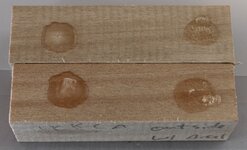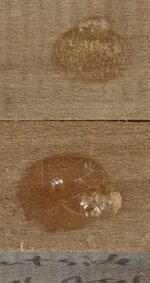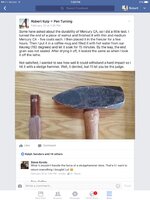Quality Pen
Member
Here is an experiment that I did to help us all learn a little about CA and how it can get that "cracked glass" "mosaic" or whatever-you-wanna-call-it effect and how sunlight effects it. Not only are some people completely unaware that this happens, but as far as I've seen nobody really tested it and compared/contrasted different brands.
I'm sharing these results not because it is the end-all, be-all test, but more so to contribute to the body of knowledge that is CA and it's use for pens. In other words, I tried to account for variables but let's face it, this is real life .
.
METHOD: Anyways, I used the popular EZ Bond thick CA and applied it to a piece of the same wood and recorded my results after just about 60 days.
My four samples included:
Group A)
Group B)
Group A was kept in my house -- no direct sunlight and constantly room temperature (~70 F +/-). Group B was kept in sunlight by placing it on the dashboard of my car. This gave it a steady dose of direct sunlight during peak hours of the day.
It's worth noting that this took place in Texas around now. It does get hot in Texas, but it's not summertime hot -- so I can't say that these blanks got to over 100 F ever (don't worry I am continuing this research if you are curious ). In fact, the climate these pens experienced got quite cold at times as it occasionally reaches high 30's F.
). In fact, the climate these pens experienced got quite cold at times as it occasionally reaches high 30's F.
RESULTS: So, as you will see on the photos the left side of the wood is the "glob" of CA with no accelerant, and the glob on the right had accelerant. The top wood was Group A (no-sunlight) piece, and the bottom piece was Group B (outside piece).
Photo 2 is a close up of the accelerant portion of both pieces.
Photo 3 shows the baseline day 1 pieces.
It's worth pointing out that the results are consistent with what I've seen in pens however I never apply a single "glob" of CA on a pen. It did not seem to matter although I realize this thick application of CA is different than the "layering" technique we use when finishing a pen.
Conclusions: The non-accelerant has no cracked glass effect at all for the inside piece, but the outside piece had a single lined crack in it (top 1/5 horizontally in photo). Next, we can very clearly see that both the inside and the outside CA with accelerant pieces have the cracked glass effect.
Additionally, I tried to use a light colored wood to determine whether or not the CA has yellowed, but it is hard to gauge. There does seem to be a difference in the clarity/opacity but it is not significant after this amount of time.
Disclaimer: I don't sell CA glue
I'm sharing these results not because it is the end-all, be-all test, but more so to contribute to the body of knowledge that is CA and it's use for pens. In other words, I tried to account for variables but let's face it, this is real life
METHOD: Anyways, I used the popular EZ Bond thick CA and applied it to a piece of the same wood and recorded my results after just about 60 days.
My four samples included:
Group A)
- CA with accel kept out of sunlight with no accelerant (Lefthand side of photo)
- CA with accel kept out of sunlight with accelerant
Group B)
- CA with accel kept in sunlight with no accelerant (Lefthand side of photo)
- CA with accel kept in of sunlight with accelerant
Group A was kept in my house -- no direct sunlight and constantly room temperature (~70 F +/-). Group B was kept in sunlight by placing it on the dashboard of my car. This gave it a steady dose of direct sunlight during peak hours of the day.
It's worth noting that this took place in Texas around now. It does get hot in Texas, but it's not summertime hot -- so I can't say that these blanks got to over 100 F ever (don't worry I am continuing this research if you are curious
RESULTS: So, as you will see on the photos the left side of the wood is the "glob" of CA with no accelerant, and the glob on the right had accelerant. The top wood was Group A (no-sunlight) piece, and the bottom piece was Group B (outside piece).
Photo 2 is a close up of the accelerant portion of both pieces.
Photo 3 shows the baseline day 1 pieces.
It's worth pointing out that the results are consistent with what I've seen in pens however I never apply a single "glob" of CA on a pen. It did not seem to matter although I realize this thick application of CA is different than the "layering" technique we use when finishing a pen.
Conclusions: The non-accelerant has no cracked glass effect at all for the inside piece, but the outside piece had a single lined crack in it (top 1/5 horizontally in photo). Next, we can very clearly see that both the inside and the outside CA with accelerant pieces have the cracked glass effect.
Additionally, I tried to use a light colored wood to determine whether or not the CA has yellowed, but it is hard to gauge. There does seem to be a difference in the clarity/opacity but it is not significant after this amount of time.
Disclaimer: I don't sell CA glue




